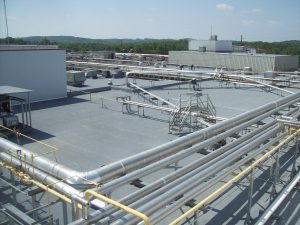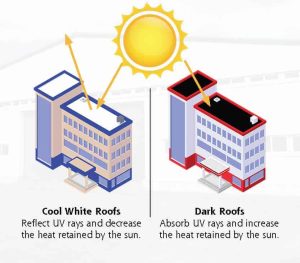Your commercial roof is your first line of defense to protect your facility from the weather; it can also play an essential role to insulate your building and regulate your energy costs.
By choosing the right insulation and roofing for your building, you could save hundreds of dollars by cutting your energy bills. You can also create a proper roof system to last decades and protect your building inside and out.
At West Roofing Systems, we specialize in commercial roofing that insulates your building and saves you money through energy costs and building protection. We work with building owners and managers to calculate the R-value they want to achieve for their buildings and helping them reach their goals.
Read More: Blackstone Pub is saving hundreds in energy costs with an SPF roof
What is R-Value?
When a contractor talks about the R-value of a material, they are talking about the material’s ability to resist thermal movement through it. The higher the R-value, the more insulation the material provides by limiting airflow between outside and inside the building.
It’s important to think about R-value when considering your roof project because by increasing the R-value, you allow your roof to keep warm air in during the winter and out during summer. The increase in thermal resistance can result in using less energy to maintain your building temperature. Your result from installing the right insulation on your building will be lower heating and cooling bills.
 R-Value Requirements
R-Value Requirements
Building codes across the US have different required R-values for roof systems. The minimum R-value is determined by the local jurisdiction, and your contractor should take it into account when planning your roofing project. By not adhering to your area’s building codes, you risk failing building inspections, paying to install the correct insulation and possibly having to pay fines.
Read More: Minimum Insulation R-value Requirements: Non-Residential
What Are Common R-Values?
R-value is calculated by more than just the insulation. To calculate the R-value of a roof system, your contractor will take into account the underlayment, coverboards, adhesives, insulation and even the membrane.
The average R-value for some common roof materials include:
- Spray Polyurethane Foam: 6.6 per inch
- XPS Insulation: 5.0 per inch
- EPS Insulation: 3.85 per inch
- Polyiso: 5.5 per inch

White vs Black Commercial Roofs
Saving Energy with Roof Reflection
Having a high R-value is not the only way you can save money on your energy savings. Silicone roof coatings are often referred to as “cool roofs” due to their ability to keep facilities cool.
The bright white color reflects UV rays, saving buildings up to 35% in energy costs from not needing as much air conditioning to keep the facilities cool. Utilizing a bright white coating application reduces energy costs as part of the energy star cool roof solution.
West Roofing Systems, Inc. installs sustainable and efficient roofing systems for commercial, industrial, manufacturing and municipal buildings. In over 40 years, we have installed over 60,000,000 square feet of commercial roofing, and our expert team is ready to help you.
If you are looking for maintenance, repair, or replacement of your facilities roof, fill out our quote form for your free no-obligation commercial roof quote from our team of experts.
Read More:


